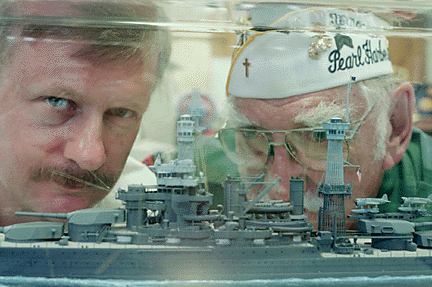


Model maker
By Burl Burlingame
scales the past
Star-BulletinMore than half a century ago, Marine bugler Dick Fiske called the great battleship West Virginia home. He strolled her wide decks after evening chow, marveled as her clipper bow knifed through mountain-sized waves, traded sea stories with the sailors, felt part of the vast humming hive that made up a battleship and crew.
It felt as if the ship were alive, a creature of steel and teak, and the crew was the lifeforce that swam through her veins.
Within a few minutes on Dec. 7, 1941, eight Imperial Navy torpedoes blew out the ship's port side and West Virginia lurched onto the bottom of Pearl Harbor, bending her spine. Fiske was homeless.
The ship was raised and rebuilt, and participated in fierce fighting during the last year of the war, but she was never the same again. Fiske survived the war as well, and volunteers as a Pearl Harbor survivor at the Arizona Memorial Visitor Center. His days on the "WeeVee" are a distant memory.
When policeman Chris Preston of Victoria, British Columbia, began building a model of the West Virginia, he had the sacrifices of veterans like Fiske in mind. Model manufacturer Tom Harrison of Tom's Modelworks had contacted Fiske while creating the kit, and Preston agreed to build up the "test shot" of the kit.
The kit, in 1/350 scale, makes for a battleship model about a foot and a half long and has hundreds of detailed pieces. As he completed the model, Preston and Harrison thought it appropriate that Fiske be presented with the finished product. So, when Preston -- a reservist in the Canadian military -- flew to Barbers Point recently, he brought the completed model with him. It's mounted in a case, portrayed ploughing through an "ocean" of acrylic glaze.
They met at the Arizona Memorial center last week. Fiske was open-mouthed at the staggering level of detail on the tiny model.
"It's like it was yesterday," he said. "I can just about tell where everything and everyone was. I can practically see the guys standing watches, the guys I knew."
"Is it missing anything?" asked Preston.
"Near as I can tell, I think only a couple of boats, and the range clocks aren't there," mused Fiske, talking about the clock-shaped disks attached to the masts for gunnery signalling.
Arizona Memorial historian Daniel Martinez pulled out several picture books of the attack, and the three pored over photos of the West Virginia aflame in the harbor. The range clocks weren't visible. "Well, well," laughed Fiske. "You got it right after all."
It's possible, said Preston, that the clocks were removed shortly before the attack.
This obsessive attention to detail is what separates "scale models" from toys, explained Martinez. Preston even mixed "scale color" to paint it with. He matched the paint scheme to color chips of Navy ships of the period, then lightened it to account for atmospheric distortion. A 1/350 model viewed from a foot away, for example, is like looking at the real thing from 350 feet away. An exact color match is too intense.
Fiske didn't care about the rationale of scale artistry. He was transported back in time, looking at a memory come to life. "I was there, on the quarterdeck, when the attack began," he said pointing. "I ran down the port side and up the ladders ..." -- he traced his path -- "... to my position on the bridge. We saw the white wakes of the torpedoes coming in. They hit, here! And here! God, the noise they made."
Fiske said he was near tears.
"I can't explain how I feel too much. If I do, I'll break down. It's the most beautiful model I've ever seen in my life. I'm in seventh heaven."
And so Fiske, the tough Marine veteran, and Preston, the laconic cop, shook hands the way guys do, long and hard, when there's too much to say and words are inadequate.
Click for online
calendars and events.